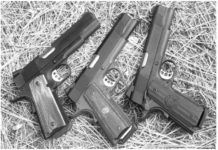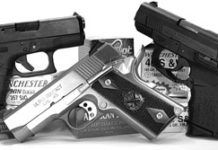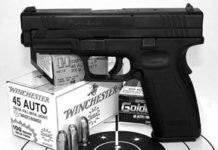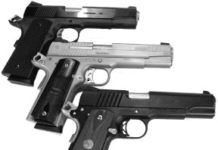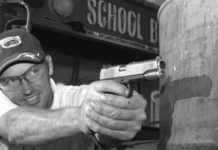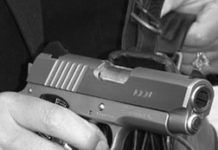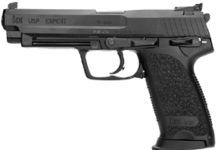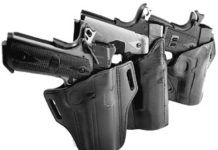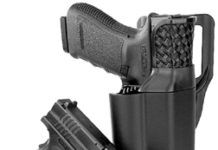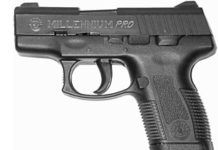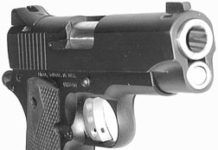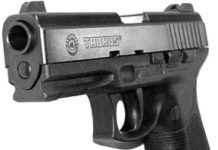High-Dollar 1911s: Wilson CQB Beats Nighthawk, Rock River
Subcompact Power: .45 ACP, .40 S&W, and .357 SIG Guns
Recently we received a letter from a subscriber who asked us to compare a small .45 ACP 1911 pistol to some of today's more popular options in the category of subcompact pistols. Keynotes of comparison were action design, similar size, and similar stopping power. Also, our reader wanted us to compare the speed and integrity of fundamental controls other than the trigger. A concealed-carry gun may never be reloaded during a confrontation, but you wouldn't want to drop the magazine by accident or fumble releasing the slide.
Your competition or hunting gun may be the love of your life but a powerful subcompact pistol is the one you are likely to spend the most time with. In this test we'll get up close and personal with three pistols small enough to blend in with your lifestyle and powerful enough to preserve it. The Springfield Armory Ultra Compact 1911A1 PX9161L, $952, represents the traditional .45 ACP single-action single-stack pistol. The Glock polymer pistol is another very popular option. The Glock 33 No. PI3350201, $599, is chambered for .357 SIG, which offers .357 Magnum power in a controllable high-capacity platform. Smith & Wesson's SW990L in .40 S&W is also a polymer pistol with a double-column magazine, but distinguishes itself from the Glock pistol by utilizing a Walther design. Our SW990L No. 120233, $729, like the others, employed approximately a 3.5-inch barrel, and all three were specifically designed for concealed carry.
New Semi-Auto Power Pistols: Springfields XD 45 Is A Winner
Two recent pistol introductions have been much-ballyhooed in the gun press and firearms industry: Springfield's XD 45 and the Smith & Wesson M&P 40. At the NRA annual meetings in Milwaukee May 19-21, the new XD pistol in .45 ACP won Handgun of the Year notice from NRA's American Rifleman magazine, and it won Handgun of the Year at the Shooting Industry Academy of Excellence awards. The S&W M&P .40 was likewise nominated for the Shooting Industry award, and another NRA publication, Shooting Illustrated, named the M&P as its 2006 Handgun of the Year.
Because interest seems high, we wanted to weigh in on which pistol we thought was the best, so we acquired a $559 Springfield Armory XD (Extreme Duty), and a $624 Smith & Wesson M&P (Military and Police) pistol. Of course, both were designed to provide an effective weapon for law enforcement and military use, but they certainly will serve as personal defense guns for civilians that are durable, easy to maintain and within most budgets.
The XD is based on the Croatian police sidearm that Springfield Armory has adapted to the American market. Chambering the XD for .45 ACP is the latest volley aimed at landing the XD in the holster of every policeman. The XD is a proven design, but we wondered how the power and size of .45 ACP ammunition would affect the integrity of the machine as well as the friendly ergonomics that have attracted so many buyers in other chamberings. The Smith & Wesson M&P 40 S&W is the result of research and development that included consultation with the law enforcement and military training community. Starting with a clean slate, Smith & Wesson has risked much more than Springfield Armory by having to spend money on tooling up. Was it worth the investment?
A Fresh Crop of Full-Size 1911s: We Choose the Para-Ord SSP
In this review we will evaluate three 1911 45 ACP pistols relatively new to the market. Each one was manufactured by names first associated with pistols other than the single-stack Browning design. For instance, Para-Ordnance is a Canadian firm most famous for introducing high capacity to the 1911 by enlarging the receiver to house a double-column magazine. STI International is known for its modular design melding a polymer grip to a set of rails to produce a high capacity pistol also fed from a double stack magazine. Sigarms has been making a single stack .45 for many years, the P220. But the P220 is closer to Browning's BDA design, operating with a traditional double-action trigger. Sigarms's single-action gun, the GSR Revolution, costs $1,049 and this puts it squarely between the $1,344 STI Lawman 5.0 and the $899 Para-Ordnance SSP.
We began our tests by removing the top ends of each gun and making sure they were properly lubricated. All three guns were function fired with a variety of ammunition left over from other tests, then loaded with at least 200 rounds of a handload featuring the 200-grain lead-swaged bullet from Precision Bullets (www.precisionbullets.com) that offered molybdenum coating to minimize deposits. Alliant Power Pistol smokeless powder was the propellant, ignited by Winchester large primers. We recorded accuracy data at an outdoor range from a 25-yard bench rest with this round plus three factory loads. They were 200-grain +P Speer Gold Dots, Federal's 165-grain Hydra-Shok JHP rounds, and the Atlanta Arms and Ammo 185-grain JHP match ammunition, (www.atlantaarmsandammo.com). This is the same load used by the United States Army Marksmanship Unit, (AMU). Our test team members believed that any full-size gun in this price range should deliver five-shot groups measuring approximately 2.5 inches or less and run without any problems. Let's see how these new .45s did when examined by our critical group of shooters:
Lightweight .45s: The Bi-Tone Looks Great and Shoots Great
In this report the Smith & Wesson 1911SC will be matched head to head with Springfield Armory's Service Model 5-inch Lightweight Bi-Tone pistol. We will also reflect upon our recent test of the Kimber Tactical Custom II and bring our findings of the three pistols up to date. The ammunition used to test-fire the Springfield Armory and Smith & Wesson pistols was the same selection used in our test of the Kimber published in the November 2005 issue. The Kimber was re-chronographed along with our current two pistols to account for the change in temperature between test dates. consisted of Winchester's 230-grain FMJ and JHP rounds plus 185-grain JHP rounds from Black Hills Ammunition. Test distance was once again 25 yards from a bench rest. Since each of our guns was priced above $900 MSRP, we expected tight groups without malfunctions or breakage. If each gun came through as expected would we be able to make a clear choice? Only the shooting will tell.
Small .45s for Concealed Carry: Light DA Versus Single Action
A lot of shooters still like a small, concealable .45, but they wonder about simplicity in operation: i.e., should they stick with the tried-and-true single-action 1911 cocked-and-locked formula, or go to a double-action trigger? In this test we will look at two competing ways to conceal and deliver the .45 ACP using a smaller-sized handgun, and also see how two new guns stack up against a previously tested gun of similar size and operation.
Our fresh test products were the Springfield Armory Micro Compact LW Bi-Tone Operator, a traditional single-action 1911 greatly reduced in size from a full-size gun, $1,247. The second gun was a Para Ordnance CCO CWX745S, $1,049, a full-time double action.
We collected using a 15-yard sandbag rest, but we also tried rapid repeat fire to gauge how the guns would work straight out of the holster, looking in particular at how the difference in the triggers would affect accuracy, rapid fire capability, and safety. To test the guns, we shot self-defense loads from Winchester (185-grain FMJ and 230-grain SXT JHP rounds) and 200-grain TAP FPD hollowpoints from Hornady.
Also, we evaluated these products from a historical perspective, gauging how they fared against a top-ranked gun we've already tested and liked. If the new guns offer performance equal to or better than what we've already seen, then they'll get our nod here. If not, we'll tell you what guns are better buys, and why.
Here's what we found:
Pricey Polymer Pistols: Buy the Heckler & Koch USP Expert 45
HK's USP Expert 45 .45 ACP is a rugged combat pistol with accuracy and versatility. We can't recommend Kimber's Gold Match Ten II because of function problems we encountered.
Alloy-Frame 1911s: We Choose Kimbers Tactical Custom II .45
Springfield Armory's Lightweight Champion GI wouldn't shoot hollowpoints, and we didn't like the laser grips on Smith & Wesson's 1911PD. The Kimber had but one easy-to-fix flaw.
Springfield Armorys .45 GAP Takes On Glocks in .45 ACP
Glock created the .45 GAP for its polymer pistols, but Springfield Armory's XD 45 puts the round to good use as well. What would happen when we compared it to the 21 and 21C?
Three Tiny .45 ACPs: We Pick The Taurus Millennium Pro
Glock's 36 is barely okay, in our estimation, and we had doubts about the Para Warthog's ability to shoot comfortably.
Lightweight Commander-Length .45s: Buy Kimbers Pro Carry II
Also, we loved Colt's Gunsite CCO, but it had what we thought was a fatal flaw, and S&W's SW1911 Sc may not go bang.
Full-Size Double-Action .45s: Taurus, Ruger Go Head To Head
The new Taurus 24/7 is a great combat gun, and we liked Ruger's P345, but the person shooting the Taurus PT 945 must have big hands to get the right shooting grip.































